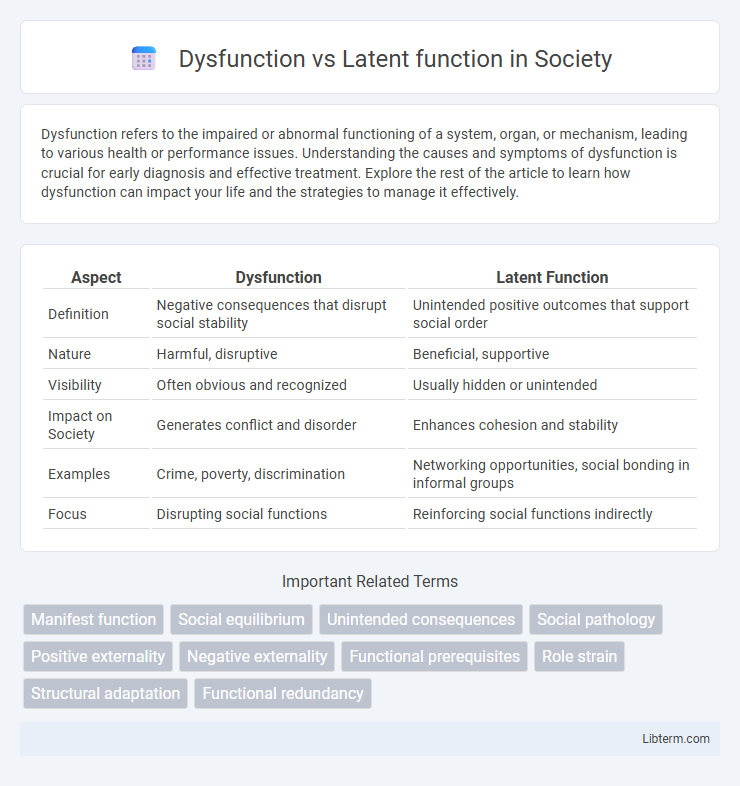Dysfunction refers to the impaired or abnormal functioning of a system, organ, or mechanism, leading to various health or performance issues. Understanding the causes and symptoms of dysfunction is crucial for early diagnosis and effective treatment. Explore the rest of the article to learn how dysfunction can impact your life and the strategies to manage it effectively.
Table of Comparison
| Aspect | Dysfunction | Latent Function |
|---|---|---|
| Definition | Negative consequences that disrupt social stability | Unintended positive outcomes that support social order |
| Nature | Harmful, disruptive | Beneficial, supportive |
| Visibility | Often obvious and recognized | Usually hidden or unintended |
| Impact on Society | Generates conflict and disorder | Enhances cohesion and stability |
| Examples | Crime, poverty, discrimination | Networking opportunities, social bonding in informal groups |
| Focus | Disrupting social functions | Reinforcing social functions indirectly |
Defining Dysfunction and Latent Function
Dysfunction refers to negative consequences or disruptions within a social system that hinder stability and social order. Latent function describes the unintended, hidden, or less obvious positive effects of social activities or institutions that contribute to social cohesion. Both concepts originate from structural functionalism, emphasizing different impacts that social elements have beyond their manifest purposes.
Historical Context of the Concepts
Dysfunction and latent function are foundational concepts in structural functionalism, developed primarily by sociologist Robert K. Merton in the mid-20th century as a refinement of Emile Durkheim's earlier work on social functions. Durkheim emphasized the positive, manifest functions of social institutions, while Merton introduced latent functions to describe unintended, often hidden consequences, and dysfunctions to highlight social elements that disrupt social stability. This historical shift allowed sociologists to analyze both the beneficial and problematic impacts of social structures, broadening the analytical scope of functionalist theory.
Key Differences Between Dysfunction and Latent Function
Dysfunction refers to negative or harmful consequences of social structures that disrupt societal stability, while latent function describes unintended and often beneficial effects that maintain social order. Key differences include the impact on society--dysfunctions undermine social equilibrium, whereas latent functions support it indirectly. Moreover, dysfunctions are typically visible and problematic, whereas latent functions remain unnoticed or unrecognized.
Examples of Dysfunctions in Society
Dysfunctions in society include crime, which disrupts social order and creates fear among community members, and unemployment, which leads to economic instability and increased poverty rates. Another example is pollution, causing environmental degradation that harms public health and reduces quality of life. These dysfunctions hinder social cohesion and impede the smooth functioning of institutions.
Illustrative Cases of Latent Functions
Latent functions often reveal unexpected social benefits, such as the role of educational institutions in fostering social networks beyond formal learning. For example, schools unintentionally serve as a venue for peer bonding and cultural assimilation, which strengthens community cohesion. These latent functions contrast with dysfunctions that disrupt social stability, exemplified by consequences like increased social inequality stemming from educational disparities.
Theoretical Perspectives: Merton’s Contribution
Robert K. Merton's theoretical framework distinguishes dysfunctions as negative consequences that disrupt social stability, whereas latent functions refer to unintended, often unrecognized, positive outcomes within social systems. His structural functionalism model emphasizes that both dysfunctions and latent functions play crucial roles in maintaining or challenging the equilibrium of society. Merton's contribution highlights that social phenomena cannot be understood solely by their manifest functions but require analysis of latent functions and potential dysfunctions to grasp their full impact on social structures.
The Role of Dysfunction and Latent Function in Social Change
Dysfunctions often disrupt social stability by causing unintended negative consequences that challenge existing norms and prompt adaptive responses within society. Latent functions contribute to social change by producing hidden or unrecognized effects that gradually influence social structures and relationships. Understanding both dysfunctions and latent functions reveals how social systems evolve through unintended disruptions and subtle, transformative processes.
Impact on Social Institutions
Dysfunctions disrupt social institutions by causing instability, impairing their ability to maintain order and fulfill societal needs, often leading to conflict or breakdown. Latent functions contribute indirectly to social institutions by producing unintended consequences that may reinforce social norms or create new social patterns, supporting institutional adaptability and evolution. Both concepts highlight the complexity of social structures, where dysfunctions challenge sustainability while latent functions enable dynamic change within institutions.
Critiques and Limitations of the Concepts
Dysfunction and latent function concepts face critiques for their inherent subjectivity and difficulty in empirical measurement, as what constitutes a dysfunction or latent function can vary across social contexts and perspectives. Critics argue these concepts lack clear operational definitions, leading to ambiguity in sociological research and potential bias in interpreting social phenomena. Furthermore, the focus on stability and social order in functionalist frameworks may overlook power dynamics and social change, limiting the explanatory power of dysfunction and latent function analyses.
Relevance in Contemporary Sociological Analysis
Dysfunctions represent negative consequences of social structures that disrupt social stability, whereas latent functions are unintended or hidden positive outcomes crucial for understanding complex societal dynamics. Contemporary sociological analysis emphasizes these concepts to reveal the multifaceted impacts of social institutions beyond their manifest purposes, aiding in comprehensive policy formulation and social reform. Recognizing dysfunctions and latent functions enables scholars to critically assess systemic inequalities and emergent social patterns in modern societies.
Dysfunction Infographic

 libterm.com
libterm.com